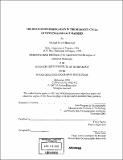| dc.contributor.advisor | Craig Taylor. | en_US |
| dc.contributor.author | Hamersley, Michael Robert | en_US |
| dc.contributor.other | Woods Hole Oceanographic Institution. | en_US |
| dc.coverage.spatial | n-usn-- | en_US |
| dc.date.accessioned | 2005-09-27T20:20:06Z | |
| dc.date.available | 2005-09-27T20:20:06Z | |
| dc.date.copyright | 2001 | en_US |
| dc.date.issued | 2002 | en_US |
| dc.identifier.uri | http://hdl.handle.net/1721.1/29055 | |
| dc.description | Thesis (Ph. D.)--Joint Program in Oceanography (Massachusetts Institute of Technology, Dept. of Biology; and the Woods Hole Oceanographic Institution), February 2002. | en_US |
| dc.description | Vita. | en_US |
| dc.description | Includes bibliographical references (leaves 153-161). | en_US |
| dc.description.abstract | I used direct measurements of nitrogen gas (N₂ fluxes and a ¹⁵N stable isotope tracer to determine the contribution of denitrification to salt marsh sediment N cycling. Denitrification in salt marsh tidal creekbottoms is a major sink for groundwater nitrate of terrestrial origin. I studied creekbottom denitrification by direct measurements of N₂ fluxes in closed chambers against a low-N₂ background. I undertook experiments and simulation modeling of sediment N₂ fluxes in closed chambers to optimize the key experimental parameters of this approach. Denitrification in these sediments was driven by the degradation of labile organic matter pools which are depleted during long incubations. Sediment thickness was the most important parameter controlling the required incubation time. Errors of up to 13% with gas headspaces and 80% with water headspaces resulted from headspace N2 accumulation and the resulting collapse of the sediment-water diffusion gradient. These errors could be eliminated by using headspaces of sufficient thickness. Headspace flushing to reduce ammonium accumulation did not affect denitrification rates, but caused transient disturbance of N₂ flux rates. Direct measurements of 0₂, C0₂, N₂, and inorganic N fluxes from the sediments of a salt marsh tidal creek were made in order to examine the interaction of denitrification with the carbon, oxygen, and N cycles. Organic carbon concentration and lability were the primary controls on metabolic rates. C0₂/N flux ratios averaged 6.1, indicating respiration driven by algal biomass. | en_US |
| dc.description.abstract | (cont.) Allochthonous denitrification accounted for 39% of total sediment denitrification (2.7 mol N m⁻² yr⁻¹). 46% of remineralized ammonium was denitrified, while the contribution of autochthonous denitrification to 0₂ and C0₂ fluxes was 18% and 10%, respectively. A ¹⁵N-ammonium tracer was used to study competition between plants and nitrifying bacteria for remineralized ammonium. In undisturbed sediments of Spartina alterniflora, plant uptake out-competed nitrification-denitrification, with plant uptake accounting for 66% of remineralized ammonium during the growing season. Under N fertilization (15.5 mol m⁻² yr⁻¹), both plant N uptake and denitrification increased, but denitrification dominated, accounting for 72% of the available N. When plant uptake was hydrologically suppressed, nitrification-denitrification was stimulated by the excess N, shifting the competitive balance toward denitrification. | en_US |
| dc.description.statementofresponsibility | by Michael Robert Hamersley. | en_US |
| dc.format.extent | 165 leaves | en_US |
| dc.format.extent | 10435902 bytes | |
| dc.format.extent | 10435660 bytes | |
| dc.format.mimetype | application/pdf | |
| dc.format.mimetype | application/pdf | |
| dc.language.iso | eng | en_US |
| dc.publisher | Massachusetts Institute of Technology | en_US |
| dc.rights | M.I.T. theses are protected by copyright. They may be viewed from this source for any purpose, but reproduction or distribution in any format is prohibited without written permission. See provided URL for inquiries about permission. | en_US |
| dc.rights.uri | http://dspace.mit.edu/handle/1721.1/7582 | |
| dc.subject | Joint Program in Oceanography. | en_US |
| dc.subject | Biology. | en_US |
| dc.subject | Woods Hole Oceanographic Institution. | en_US |
| dc.subject.lcsh | Denitrification | en_US |
| dc.subject.lcsh | Nitrogen cycle | en_US |
| dc.subject.lcsh | Salt marsh ecology New England | en_US |
| dc.subject.lcsh | Marine sediments Nitrogen content New England Measurement | en_US |
| dc.title | The role of denitrification in the nitrogen cycle of New England salt marshes | en_US |
| dc.type | Thesis | en_US |
| dc.description.degree | Ph.D. | en_US |
| dc.contributor.department | Joint Program in Oceanography | en_US |
| dc.contributor.department | Woods Hole Oceanographic Institution | en_US |
| dc.contributor.department | Massachusetts Institute of Technology. Department of Ocean Engineering | |
| dc.identifier.oclc | 50489176 | en_US |
